WWIII Team Yankee – NATO Forces Book – The Canadians

By Robert Kelly
Wow. All I can say is that almost anything Canadian that one could have wished for in the new Nato Forces book that was not in the first book is in the new edition. Christmas will be early this year as Santa’s elves in New Zealand read everyone’s wish lists and granted most of those wishes.
Canadian Airborne Regiment, Cougar, Grizzly, Leopard 2, Iltis, Tow Under Armour (TUA), ERYX, long-barreled M109s, Twin Huey and the Coyote. About the only things missing are the Leopard C2 (with and without Mexas armour), the L5 pack howitzer and the Chinook helicopter.
For extra flavour the book allows you the option of fighting with lists for 4 Canadian Mechanized Brigade Group (CMBG) in Germany or forces in Canada (Force Mobile Command) defending against a Red Dawn scenario with an invasion of Canada starting on the west coast in British Columbia.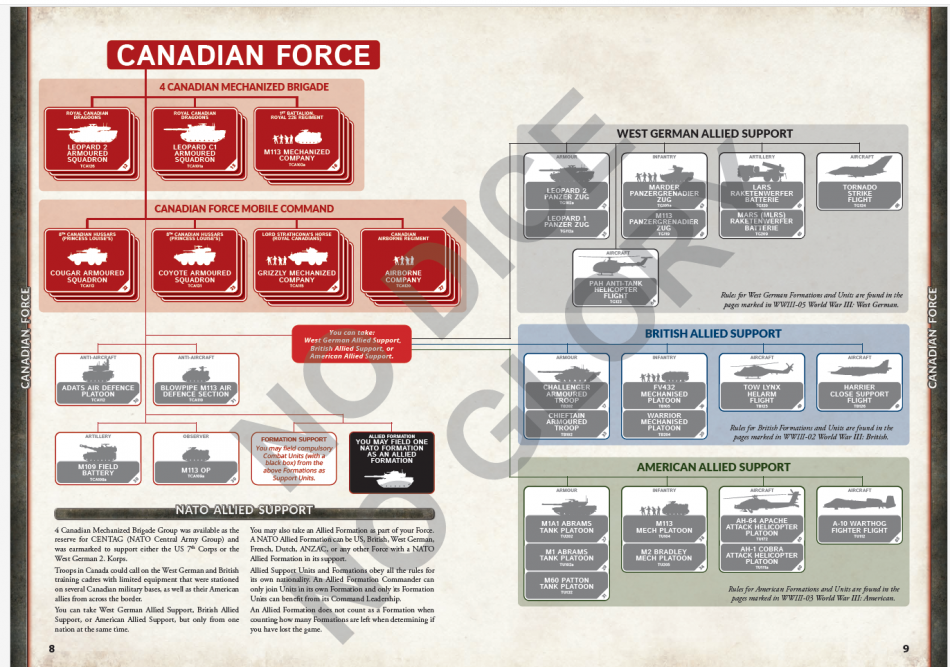
The book tried to describe the Canadian army during the time of Team Yankee, but they may have missed the mark a bit. In 1968 the Canadian Army, the Royal Canadian Air Force and the Royal Canadian Navy were unified into the Canadian Forces. The Air Force became Air Command, the Navy became Maritime Command and the Army became Mobile Command.
Force Mobile Command is the bilingual version, not some special strike force. In Germany, they correctly noted that we had 4 CMBG. In Canada, Mobile Command had 1 CMBG in the West, 2 CMBG (which became the Special Service Force for some time) in Ontario and 5 Brigade in Quebec and the Maritimes. Together they formed a division.
The brigades in Canada also had some Nato missions. The Allied Command Europe Mobile Force (Land) was a Nato formation of brigade size made up of troops from most Nato countries. It was intended as a multinational force that could be quickly deployed to any part of ACE’s command area to show the solidarity of the alliance and its ability to resist all forms of aggression against any member state. Canada provided an infantry battalion along with an artillery battery.
Some equipment was pre-positioned in North Norway and included BV 206s and some Grizzly’s. This role rotated between 1 and 2 CMBG. 5 CMBG had the Canadian Air-Sea Transportable Brigade (CAST) Group task. In time of war, they were to deploy the whole brigade to Europe. They only practised this deployment with their equipment once during the 80s. I think it would have been interesting if the book could have tied in these Nato tasks with the new Nordic Forces book or mentioned them in this new Nato book.
Unit Lists for Canadians in 4 CMBG, Germany
Leopard 2 Squadron
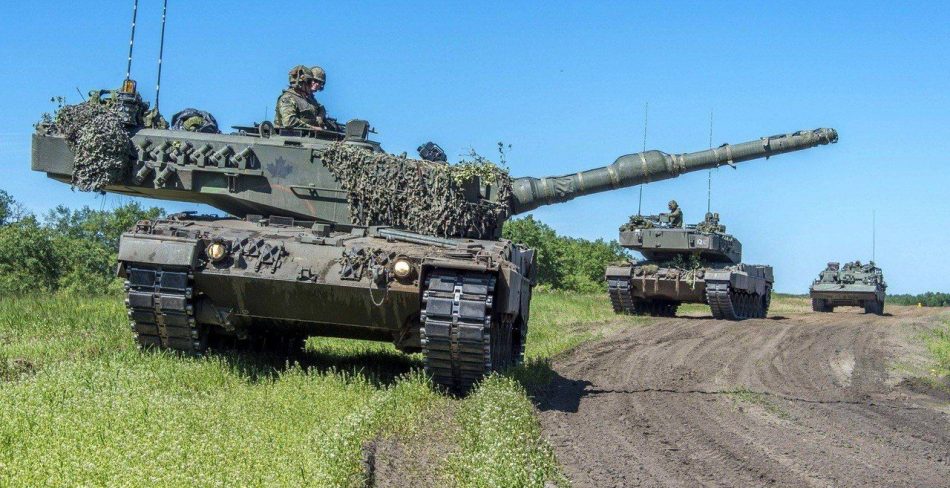
In the previous book if you wanted Leopard 2’s for your force you were limited to one platoon of up to four German Leopard 2s. Four tanks would cost 44 points. The new book explained that the Canadian government bought a regiment’s worth of Leopard 2s from the Germans and as tank crews rotated off the front lines they would return to action in Leopard 2s.
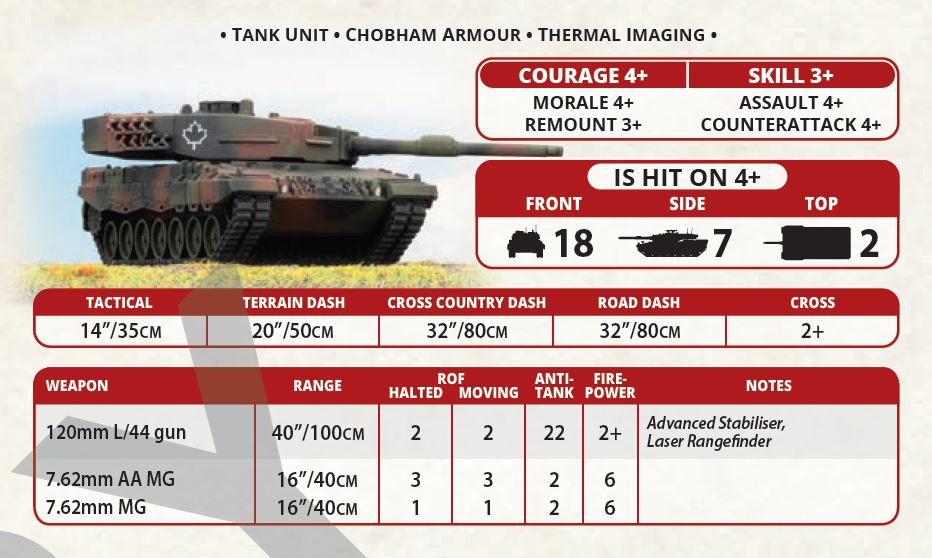
That seems plausible if the war and our tank crews lasted long enough to get it accomplished. The list allows for a two-tank HQ (why not three to be correct, I don’t know) and four troops of four tanks. You can also add up to three Lynx or Coyote Recce patrols along with a section of M150 TOW or TUA and an infantry platoon in M113s as part of the formation. The only difference between the Canadian tanks and the German ones is that the Canadians have a morale of +4 compared to +3 for German tanks. To make up for that the four Canadian tanks cost 43 points. A saving of one point.
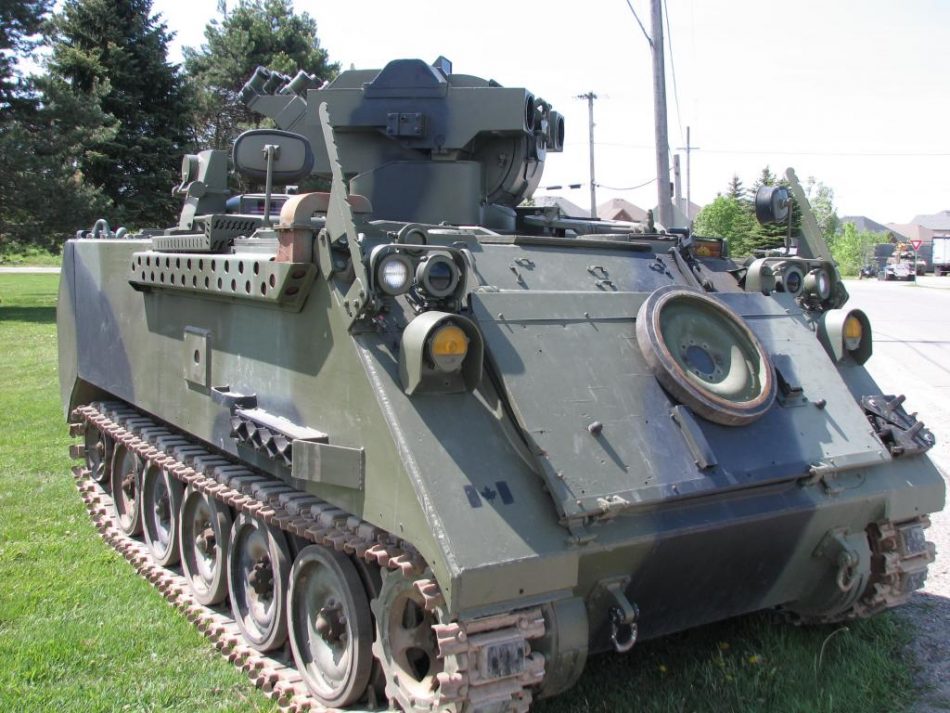
I’m very excited about TUA. Not only does it look better than the M150 TOW, but it comes with the Hammerhead rule. Hammerhead allows the vehicle to remain Gone to Ground even while shooting. If you can shoot your TUA from cover you will always be hit on sixes. The TUA also gives you the option to use TOW 2 missiles and their AT 23 versus the AT 21 for the Improved TOW missile. A section of three TUA costs seven points with TOW 2 missiles. Six points with Improved TOW missiles. M150 TOW costs four points for three vehicles and can not use TOW 2. If you take any units with TOW-2 missiles you must take ALL options with TOW-2 missiles in your Force.
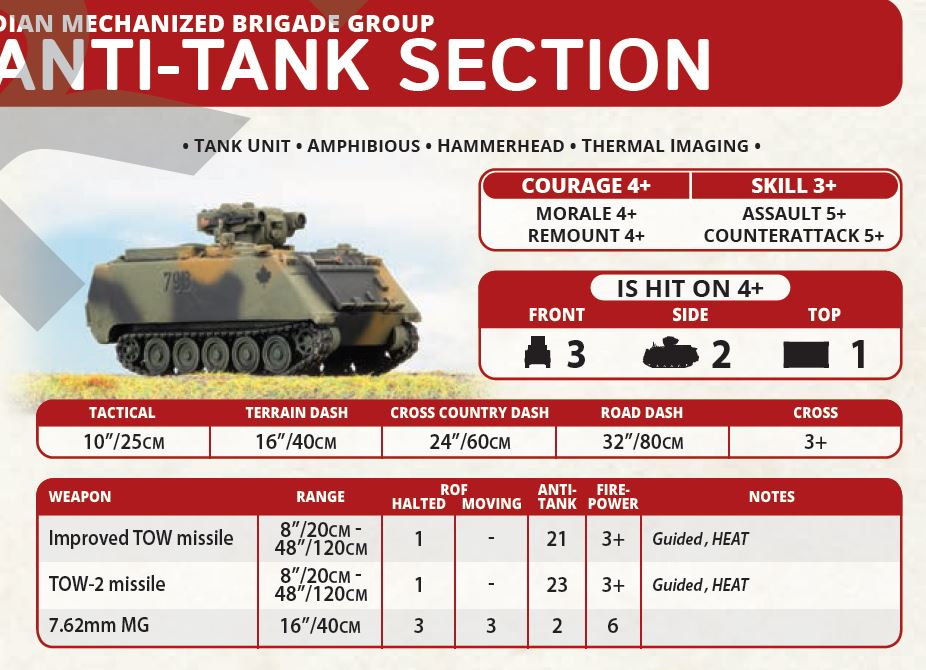
This is a powerful formation but expensive points-wise. A full 18-tank squadron would cost 193 points, and that’s without any other units added in. Having said that, I’m going to find a way of incorporating Leopard 2s into my army.
Leopard 1 Squadron
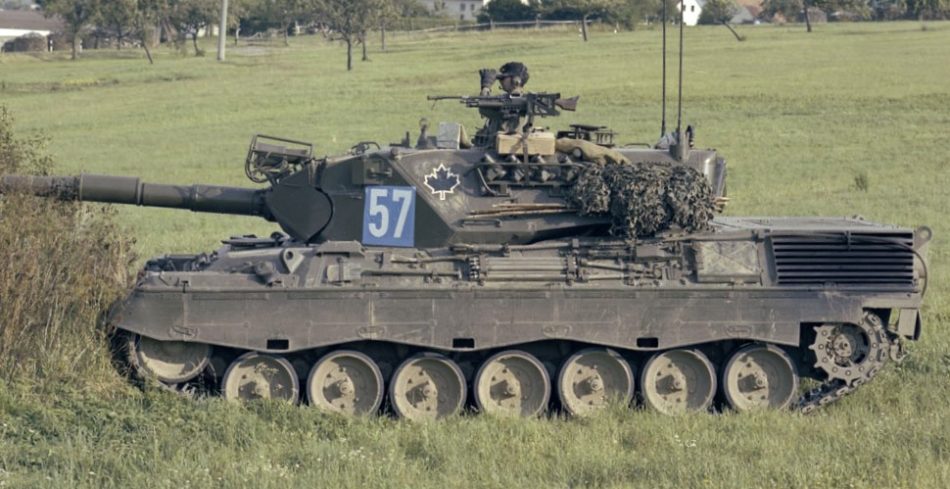
The only difference between the list from the first book and the new one is the ability to use Coyotes instead of Lynx and TUA instead of TOW. Canadian Leopard 1s are inexpensive and can be a good counter to BMP spam. Having a “brutal” gun, something the Leopard 2 does not have, makes them effective at destroying dug-in infantry. A mix of Leopard 2s and Leopard 1s is something to be considered.
M113 Mechanized Company
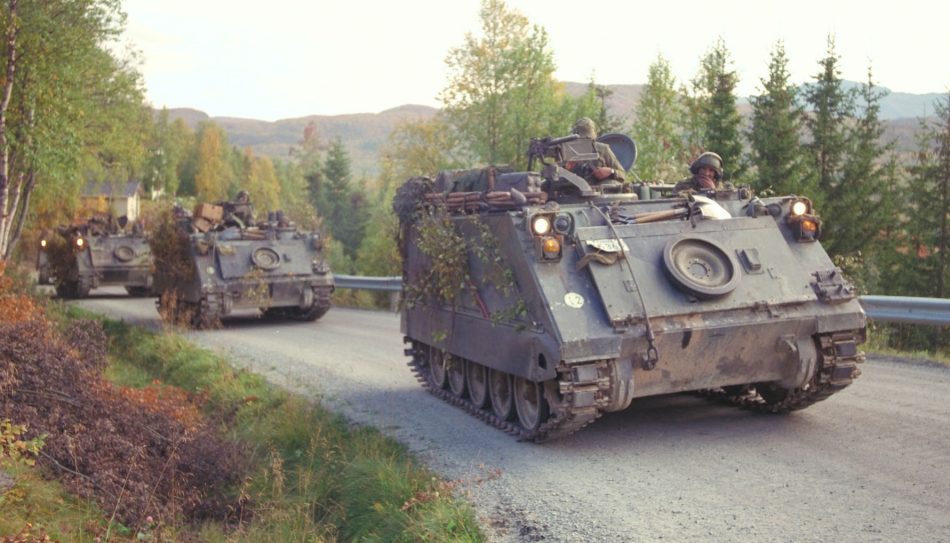
Anthony Sewards photo.
Like the Leopard 1 Squadron, there are only minor differences between the first book and the new one. Again, one difference is the ability to use Coyotes instead of Lynx and TUA instead of TOW. And you can add a Leopard 2 troop instead of a Leopard 1 troop if you wish. If you were using a German Leopard 2 Zug as part of your force, you would now appreciate having a Canadian troop as part of your formation rather than as a support choice. As in the previous book for 7-points you get a very robust infantry platoon.
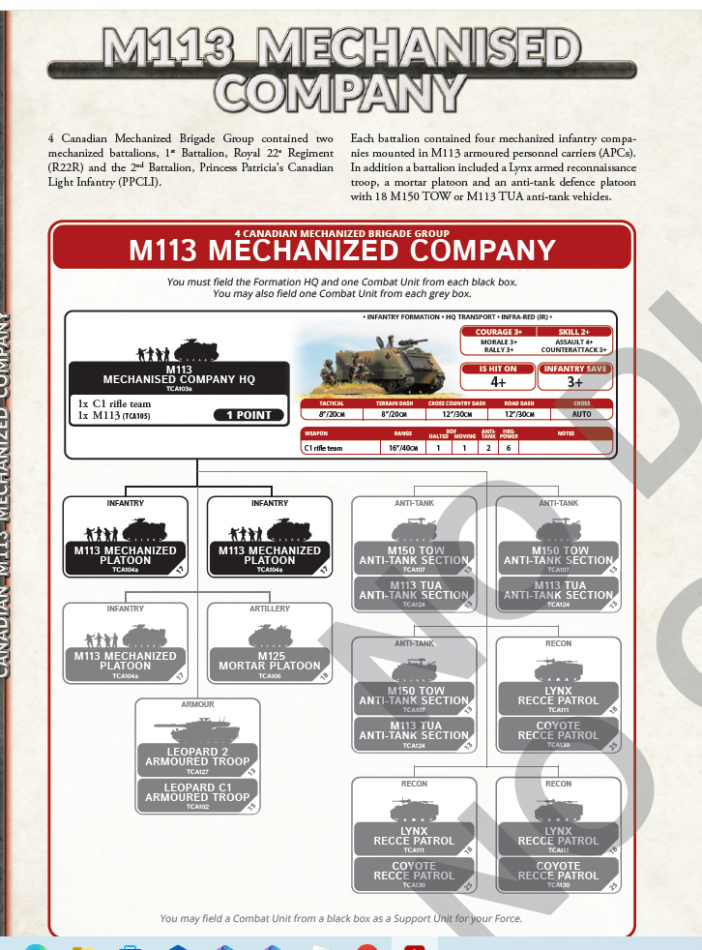
Three Carl Gustav (AT 17) teams, three M72/C2 light automatic rifle teams, a 60mm mortar and a C5 machine gun team with ROF 5. You also get four M113s mounting 50-caliber machine guns. It is not a platoon that someone will want to assault unless they have pinned you and destroyed most of the Carl Gustav teams first. What is new is the introduction of the ERYX anti-tank missile system.
For one point per platoon, you can replace your three Carl Gustav teams. It’s definitely something to think about. It has the same 16-inch range as the Carl G but comes with AT 24 and FP 4+. That is enough to scare most tanks. It also comes with the Thermal Imaging and Tandem Warhead rules. Tandem Warhead means that it is not affected by ERA armour. Another nice thing about ERYX is that there is no minimum range for the weapon even though it’s a missile system.
That is huge. The drawback is that you can’t use the missile in assault and have to rely on 2+ AT when attacking the tops of tanks. I think I’m going to add ERYX to my infantry.
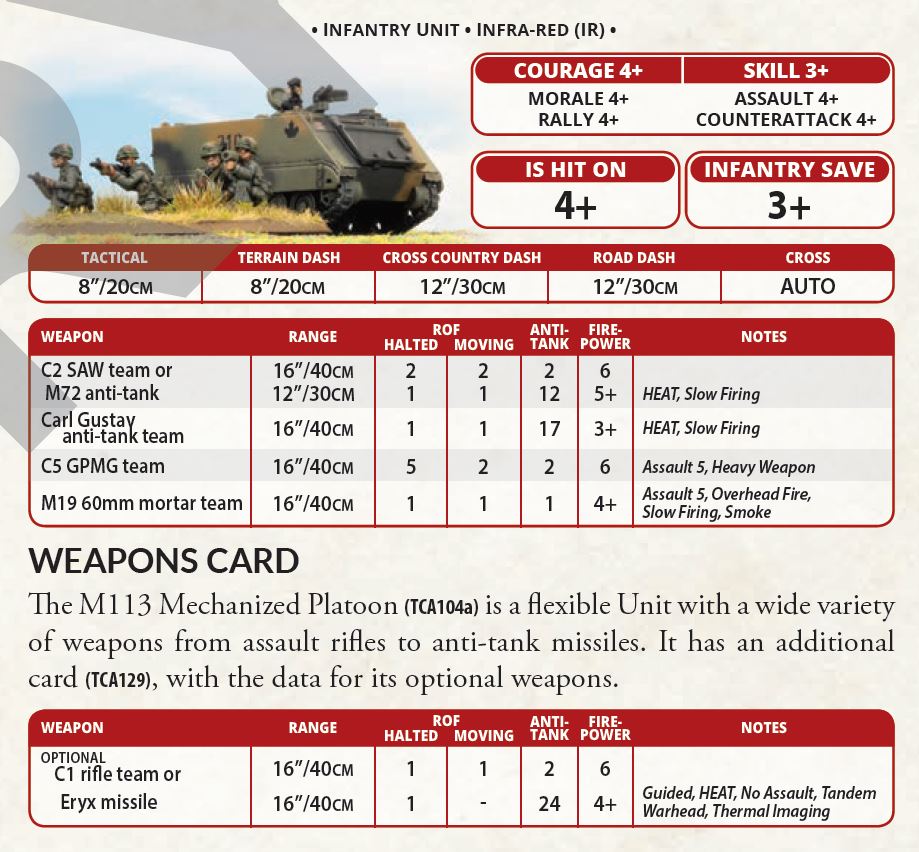
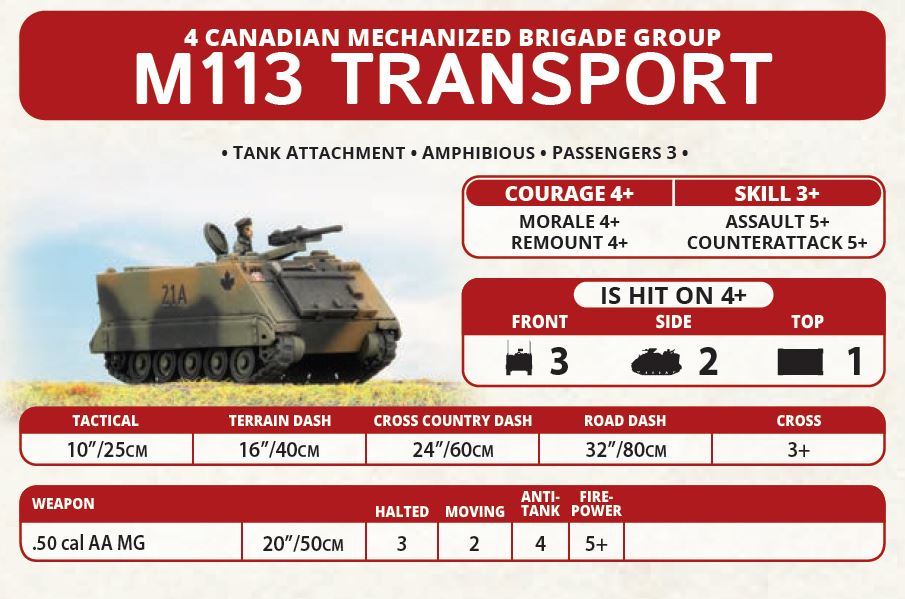
Unit Lists for Canadians in Canada
Cougar Armoured Squadron
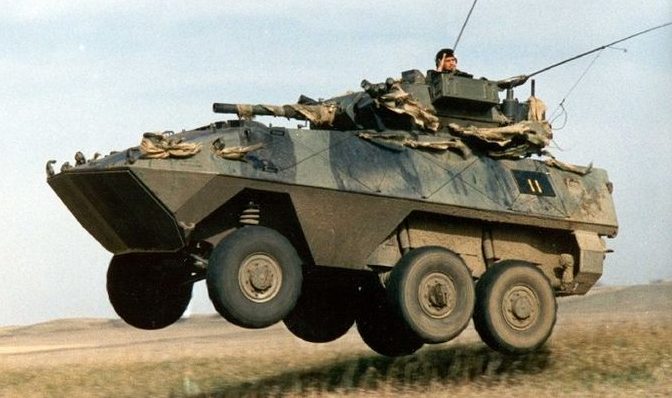
The first of the defence of Canada lists is the Cougar Armoured Squadron. I wrote about the Cougar a few years back. The Canadian Armoured Vehicle General Purpose Family – No Dice No Glory Back then I had to build my Cougars by chopping up a Lav 25 and adding a Scorpion turret. Now there is a kit.
With the exception of a squadron at the Armoured School, all of Canada’s Leopard tanks were deployed to Germany until 1993. The Cougar was provided to Regular and Reserve units as a “tank trainer” and was never intended to see action in a war zone. As an armoured vehicle, it was a poor replacement for a tank. Initially, when the main armament fired, headlights fell off!
The armoured corps once flirted with the idea that it might have some value as a replacement for the Lynx. In fact, a troop was deployed to Germany as an experiment. With the new Nato forces book, they finally get their chance to go to war. The book allows you to build a complete 19 “tank” squadron along with up to three recce patrols in either Lynx or Coyotes, a section of TOW with a pedestal mount in an M113 or on an Iltis and a mechanized platoon mounted in either M113 or the Grizzly, Cougar’s apc brother.
Cougars cost one point each so a full squadron would only cost 19 points. That one point gives you a wheeled vehicle with front armour 1 and a slow-firing AT 14 main gun. It does feature an FP of +2 for some reason, but I’ll take it. Those taking Cougars (aka Pumpkin Launchers) in their army will probably do it because they like the vehicle or for nostalgia purposes. I’m not so sure it’s a game-winner.
Coyote Armoured Squadron
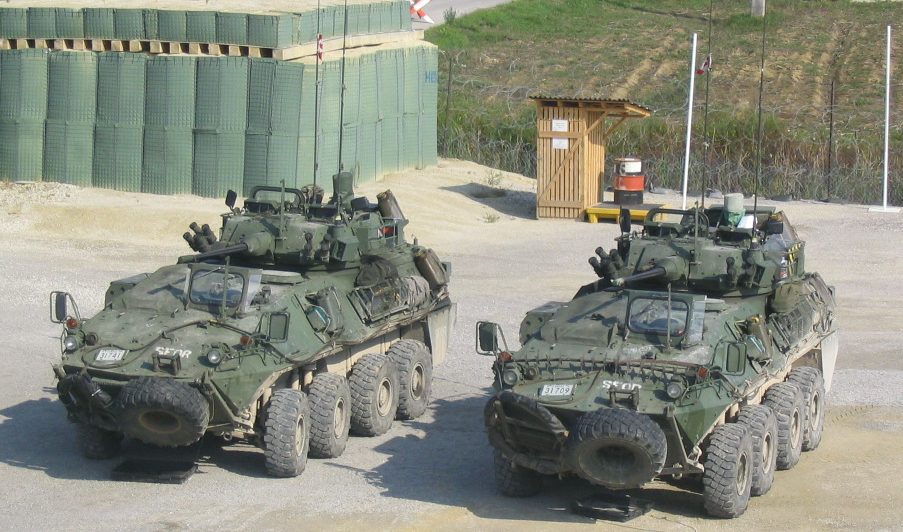

The Coyote entered service in the Canadian Army in 1996 as a replacement for the Lynx reconnaissance vehicle. It is very similar to the USMC’s Lav 25. The Canadian vehicle has turret bustles and many featuring an excellent 10-metre mast-mounted surveillance suite or a tripod-mounted surveillance system. There are no rules in the game for the surveillance systems. In fact, only the Coyote patrols of two vehicles have the Scout or Spearhead special rules.
The Coyote squadron is organized exactly the same as the Cougar squadron and each vehicle costs 1 point each as well. If your Coyote is part of the Squadron HQ or in four or three vehicle troops it only has the Thermal Imaging special rule. The idea was that these would again be used as “cavalry” or “tank trainers”. All Coyotes feature a gun that has ROF 3 whether moving or not, AT 8, the Anti Helicopter rule and an AA machine gun. The one drawback is an FP of +5. A full squadron of these can do some serious damage to a formation of BMP 1s or 2s.
Grizzly Mechanized Company
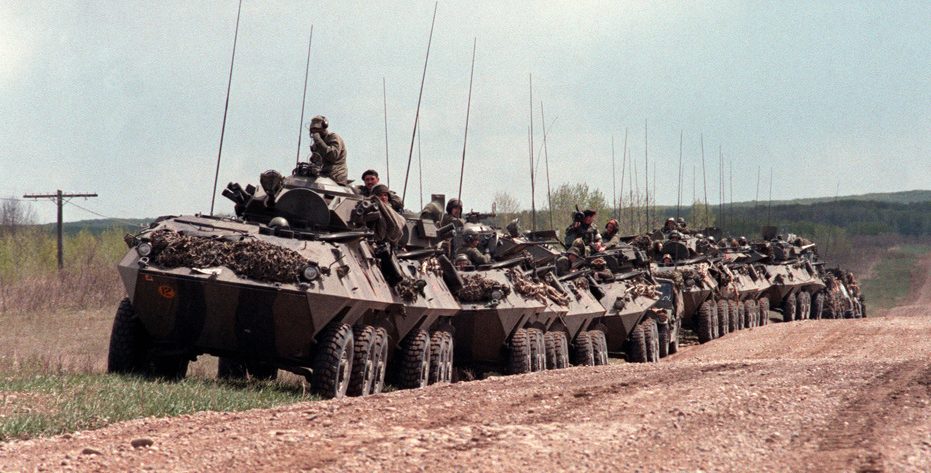
A Grizzly company doing a quick halt. One would assume that the good guys had air superiority.
The Grizzly company is organized just like the M113 company for 4 CMBG but with different equipment options. Obviously, the first difference is the Grizzly wheeled armoured personnel carrier (APC) replacing the M113. The Grizzly being wheeled has the same tactical move as the M113, but much slower dashes. The road dash is a whopping 48 inches though.
A friend who commanded a Grizzly company told me that they were amphibious and swam quite well, and much better than the 113. It could be ready to swim in minutes and the driver could activate the trim vane from within his position without exposing himself. You could almost troll off the back deck when in the water.
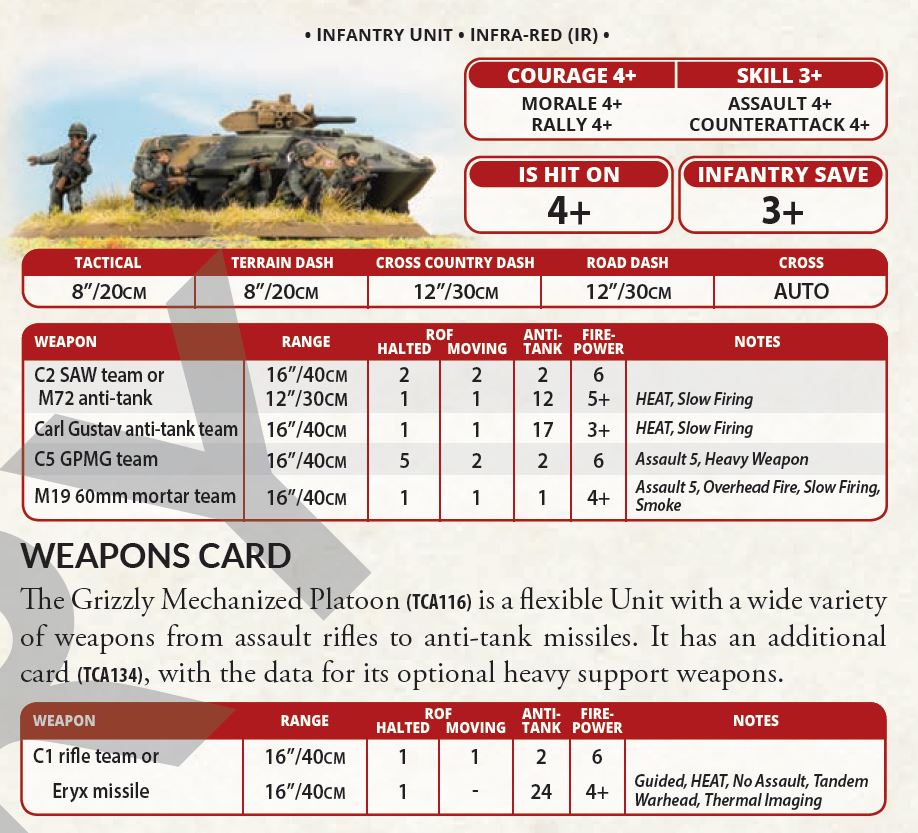

Other than their poor cross-country mobility, the Grizzly was far superior to the M113. The armour was angled, hardened Canadian steel vice aluminum alloy. Though for some reason Battlefront gives them Front Armour 1 and the M113 a 3. They mounted a .50cal and 7.62 MGs in a Cadillac Gage turret. There were firing ports in the back of the vehicle so mounted troops could fire from within the vehicle. It could easily do 70Kph on roads. It really got its bad rep from the fact it was 6×6 and its cross-country capability was bad compared to the M113. Still, on flat dry terrain, it could do fairly well. The other drawback was that it didn’t have a ramp. Mounting and dismounting infantry took longer. The Grizzly was the mainstay of Canadian-based infantry battalions.
The infantry platoons are only six points as you get only a single Carl Gustav. You still get eight stands in the platoon along with four Grizzlies, but your anti-tank ability is reduced. It still costs one point to replace that single Carl Gustav with an ERYX. There are more shots against infantry though, thanks to the Grizzlies and the two extra C2 stands.
For recce, you can choose between Lynx and Coyote patrols at two points per patrol. For anti-armour, you can have up to three TOW sections. You can’t take TUA, so it’s a choice of the M150 TOW or TOW on the Iltis. That means you can take a total of six TOWs on Iltis (two vehicles per section) for six points or nine M150 TOWs (three per section) for 12 points. For armour in the company, you will have to settle for a troop of four Cougars for four points.
While a Grizzly company will look good on the table and won’t cost too many points, it will be hard-pressed to stop any formation with tanks without some help.
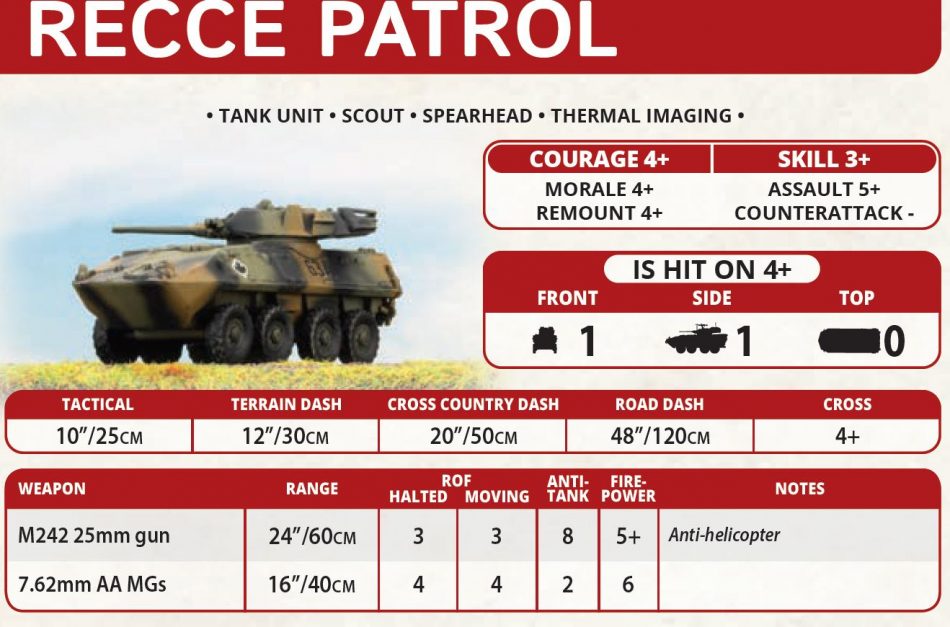
Note the different special rules for the Coyote Recce Patrol vs. the Coyote Armoured Troop.
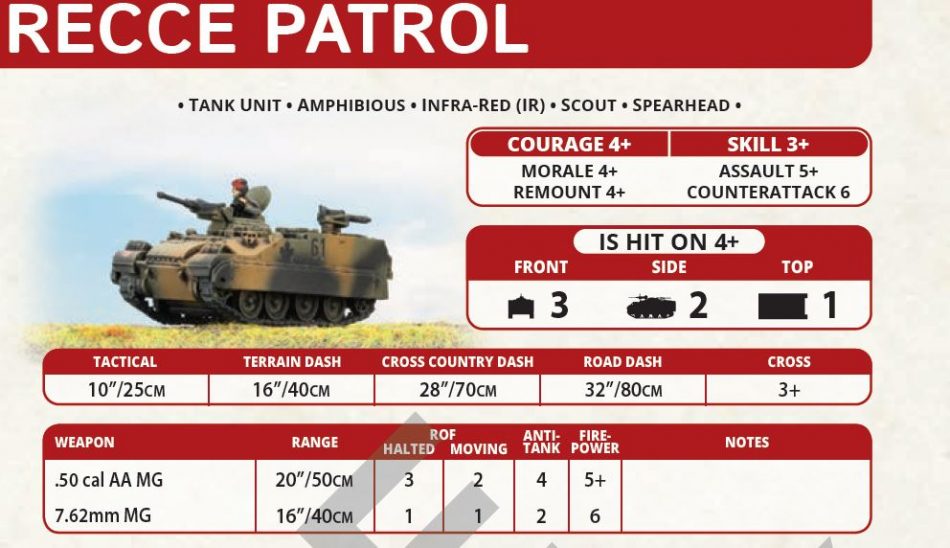
The Lynx is only available as part of 4 CMBG. Note that Battlefront has chosen to give this crew commander a maroon beret. For a few years in the 70’s, 3 Mechanized Commando of the Airborne Regiment were in Germany. Not all the soldiers were paratroopers but they wore the maroon beret and fought as a mechanized infantry battalion. It was eventually absorbed into Third Battalion, the Royal Canadian Regiment (3 RCR).
Canadian Airborne Regiment
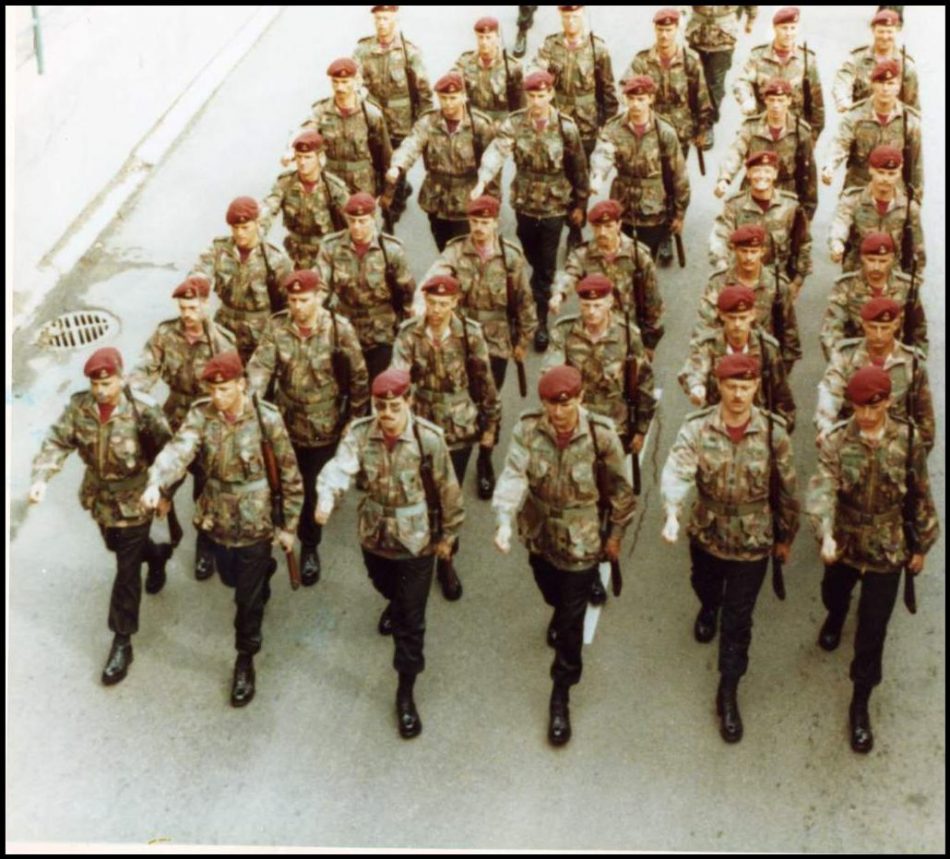
Photo from the Canadian Airborne Gunners website.
Love them or hate them, the Canadian Airborne Regiment looked cool. They were issued camouflage jump smocks at a time when the Canadian Army wore olive green combat uniforms. Eventually, the entire Special Service Force (SSF) was issued the smocks whether you jumped out of airplanes or not. As a young reservist, I thought those smocks were the coolest things out there. Some people jokingly called them the “Paint By Numbers Jacket” or the “Idi Amin Sport Coat”.
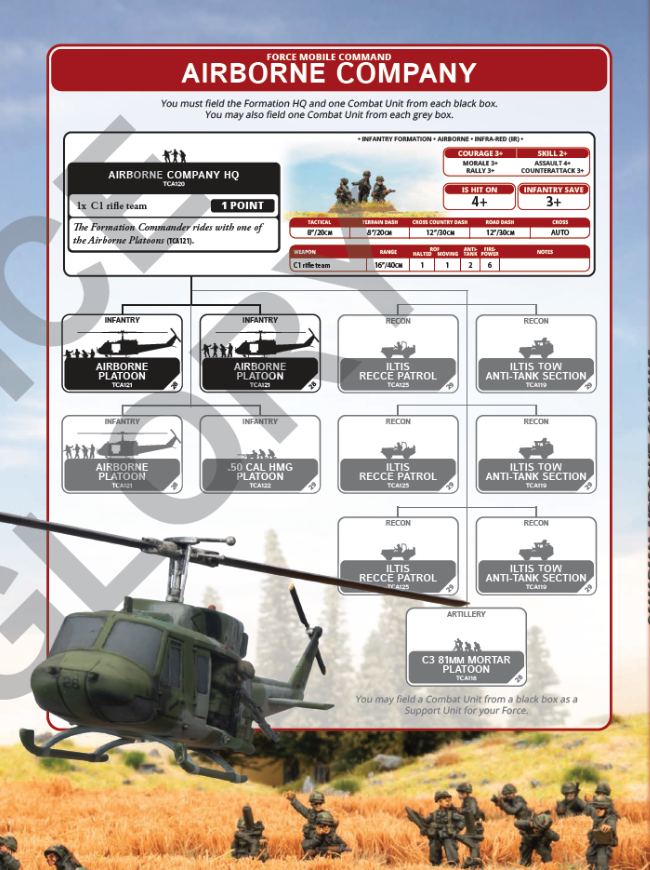 In the new book, the Airborne company (Commando) is actually heliborne having use of the Airborne rule. The formation may make an Airborne Assault in missions that use the Airborne Assault rules (page 43 of Red Dawn). Besides a single stand HQ, you can select up to three infantry rifle platoons, a 50 cal HMG platoon, up to three, two vehicle Iltis patrols, up to three Iltis TOW sections of two vehicles each and a dismounted 81mm mortar platoon. The infantry platoons come with the Twin Huey helicopters included. The mortar and HMG platoons have to pay an extra point to be transported by helicopter.
In the new book, the Airborne company (Commando) is actually heliborne having use of the Airborne rule. The formation may make an Airborne Assault in missions that use the Airborne Assault rules (page 43 of Red Dawn). Besides a single stand HQ, you can select up to three infantry rifle platoons, a 50 cal HMG platoon, up to three, two vehicle Iltis patrols, up to three Iltis TOW sections of two vehicles each and a dismounted 81mm mortar platoon. The infantry platoons come with the Twin Huey helicopters included. The mortar and HMG platoons have to pay an extra point to be transported by helicopter.
The airborne rifle platoons are very robust. For eight points you receive a Carl Gustav team, six C2, C1, and M72 teams and four Twin Huey helicopters with door guns. You can purchase up to two C5 machine gun teams for one point each as well as a 60mm mortar team for an additional point. Your Carl Gustav team can be replaced by an ERYX team for a point. Maxed out, you can field a 10-team platoon for 12 points in addition to the helicopters. That platoon will be tough to move off of an objective. What will disappoint Airborne soldiers is that their Morale, Skill, Courage etc. ratings are the same as mechanized infantry.
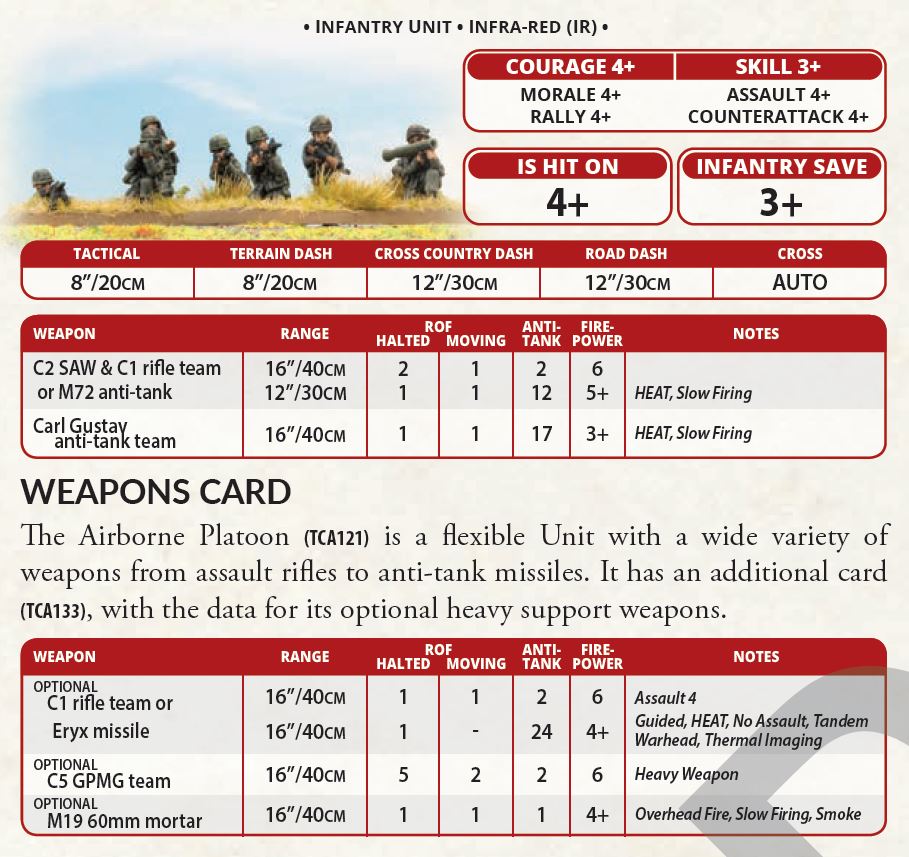
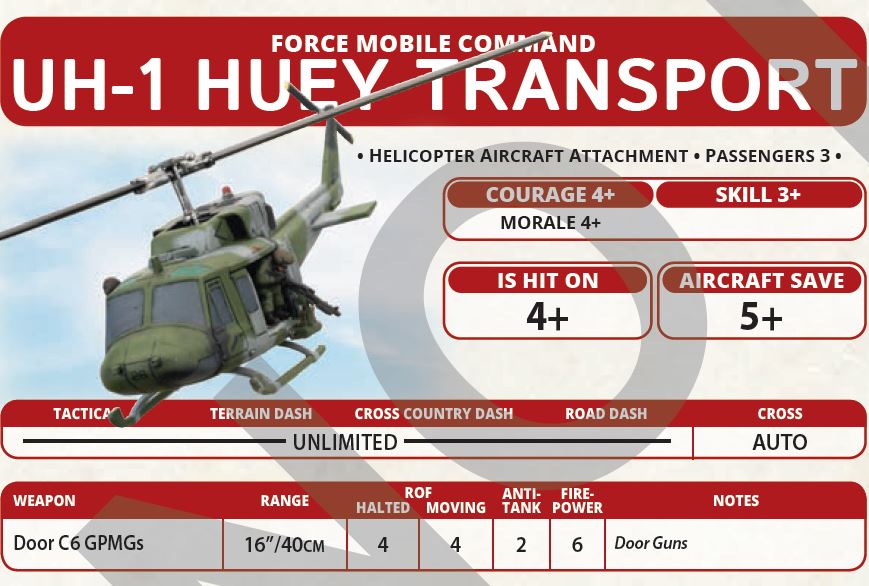
The airborne company also has many other options. First up is an 81mm mortar platoon. A full platoon of eight mortars will cost four points. A “group” of four tubes will cost two points. You can purchase a Huey at one point for every two mortars. When the Canadian Airborne Regiment was stood up in Edmonton in 1968 it included an integral artillery battery equipped with the 105mm L5 pack howitzer and 81 mm mortars. Although they were trained artillerymen, they all wore the Airborne Cap badge. When the regiment moved east to Petawawa, Ontario, in the late ’70s, the Airborne Battery became E Battery (Para) of the Second Regiment, Royal Canadian Horse Artillery (2 RCHA). I would like to do up a battery of L5s and I could even play them as mortars if I had to. I think it would look really cool.
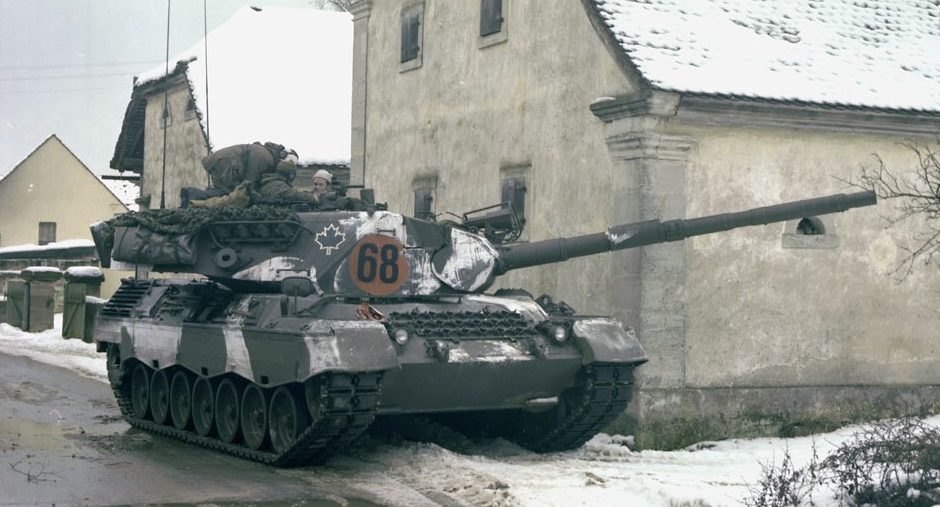
Next up is the machine gun platoon of 50 cal heavy machine guns. This never existed in real life. Though at one time there was a C5 medium machine gun platoon. For four points you get eight machine guns, which will really help the formation hold on to an objective. Six guns will cost three points, while four guns cost two points. One Huey can lift two gun teams and costs an additional point. I can see these being quite effective. I’ve always wanted the option for Canadian mechanized infantry to be able to dismount their 50 cal machine guns, send the carriers to the rear and dig them in with the rest of the company, just like they did in real life. Anyways, if I have an airborne company, I’m getting some of these machine guns.
Lastly, we have the Iltis jeep. They were small and nimble. Rumour has it, that they were designed to be able to drive between trees in German woods. German trees being planted a uniform distance apart. When we first received them, I was very impressed with how fast they were and not pleased with how small they were. If you were the “Gib” (the guy in the back) wearing full winter kit, it was not easy to get in and out of the vehicle. For a single point, you get a patrol of two vehicles each armed with a machine gun. It’s the only way the company can get Scout and Spearhead rules. You can take up to three of these patrols. For heavy anti-armour, you can take a pair of TOW mounted on the Iltis for two points. You are allowed up to three pairs in the company.
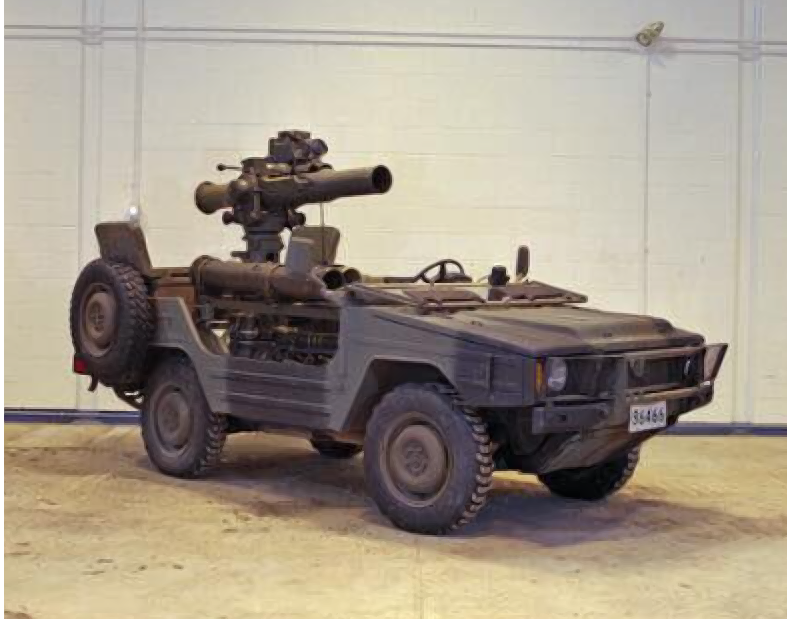
An airborne commando is definitely something I want to build. If only because of the jump smocks and the L5 howitzer battery (posing as mortars). I’ve been trying to get the cam pattern right for the smock for some time now, but with an official list, I’m going to re-double my efforts to master it. If you like the look of the jump smocks but prefer mechanized infantry, the 1st Battalion, Royal Canadian Regiment, were issued the smocks when they joined the SSF. They were mounted in Grizzly’s. One final note is that the jump smocks were only worn as a garrison uniform and for “Dog and Pony Shows”. They were not worn in the field.
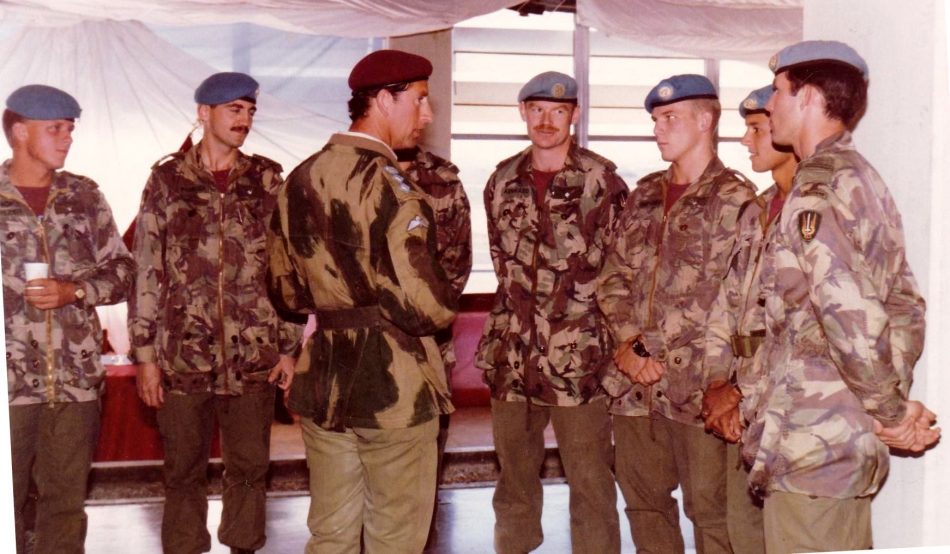
Canadian Support Units
This book also allows you to take an M109 Howitzer battery. The previous book only allowed the Canadians to take the sort barreled M109s. This made no sense as Canada started to upgrade their vehicles to the long barrels in 1976. That error has been corrected in this book, though you can still get the short-barreled guns. Getting the new guns with their longer range (direct and indirect) and higher AT value will cost you an extra point. Small price to pay for the correct guns. A troop of three guns is always something you should fit into your army as the Brutal rule, especially on a repeat bombardment is devastating against dug-in infantry. If you have an extra point, it’s always nice to take an observer. With an observer, you are ranging in on 2+ as long as there is no terrain involved.
For air support you can call in aircraft from the country that is supporting your force. A-10s for Americans, Tornados for the West Germans and Harriers for the British. To shoot down enemy aircraft, the ADATS is a no-brainer. Six systems for 15 points, each with ROF three against aircraft and ROF one against armour with a ridiculously long range and AT 24 makes them a must for Canadian Forces. Besides the jump smocks, it’s the one piece of equipment that every other army wishes they had. For about half the points, you can still take Blowpipe missiles on M113s.

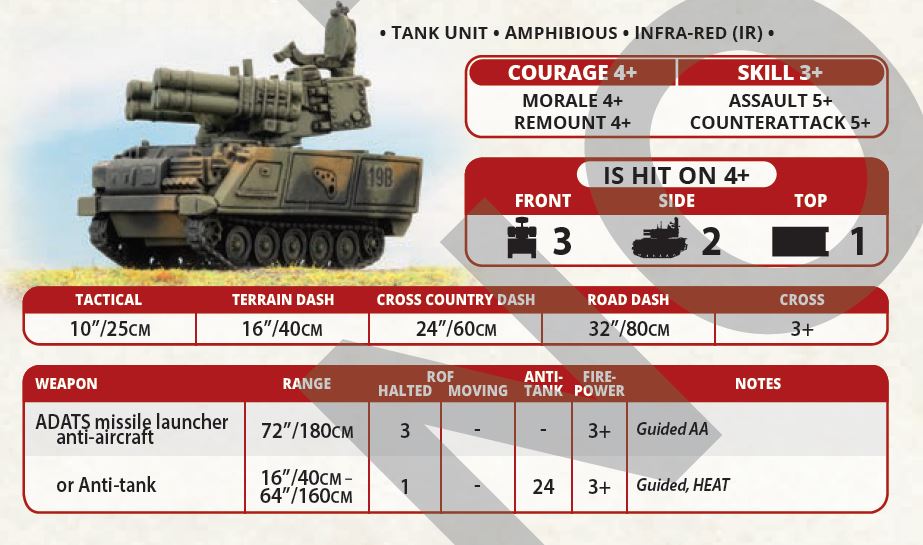
I realize that Battlefront wanted to come up with a common camouflage pattern for Canadian vehicles, but it’s not that easy. During the Cold War and beyond, Canadian vehicles had different paint schemes depending on the vehicle and when it was in service. On the common pattern that Battlefront used they somehow got one of the greens totally wrong. In a future article, I will add to my series on painting and modelling of Canadian vehicles and infantry just in time for the new models to hit the store shelves.
One last WOW for the list of possibilities for Canadians. I’ve already started painting my Airborne troops in jump smocks. I’m also working on a winter camouflage Canadian company along with a Desert Storm “What If” Canadian force. Good thing I’m retired with time to paint as there are just so many options for Canadians now.

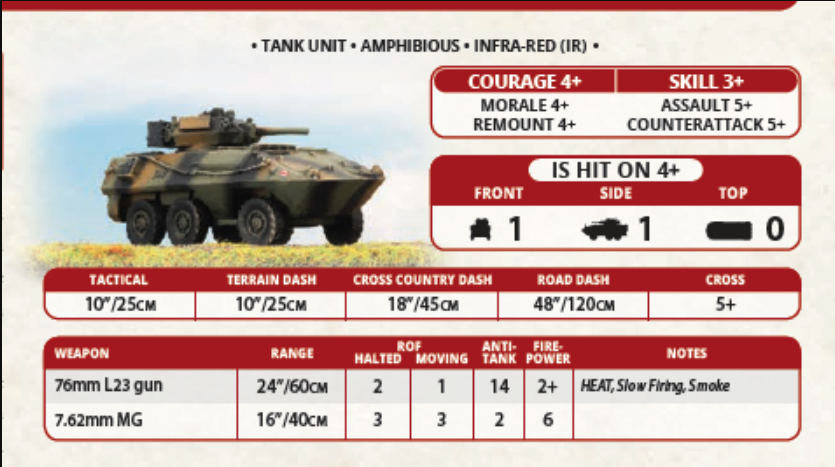
Robert, one of the best NDNG articles I’ve read in a long time! Ok I’m bias as I’ve been chomping at the bit for weeks to find out details on the Canadians.
You’ve scratched all my itches, except for being able to get my hands on the actual products, which, like Christmas will eventually come.
I was very happy to finally be able to see the force diagrams, the addition of British allies, details on TUA, and information on Grizzlies & Coyotes.
Thanks again for such a well written detailed look. I’m anxious to see your follow-up articles and I would also love to see you write about the winter and desert painting schemes for the Canadians!
Thanks for the kind comment. I’ll be sure to share my Desert Storm and winter Canadians.
Agreed!
I’m pretty excited about most of this info, having lots of new options really expanded the Canadians into almost a full force of it’s own. The TUAs, Eryx, expanded NATO support, multiple infantry and tank lists…
but there were a few things that seem a little disappointing:
– Expensive Leopard 2s – we only save 1 point for having Morale 4+?
– Cougar has HEAT – When I first saw AT 14 I thought we would be able to go flank hunting like Marder 2s
– Grizzlies not amphibious and has terrible armour
– Only one Carl G in Grizzly and Airborne Units – is this historically accurate? Did they just expect to fully rely on support weapons to deal with armour?
I guess I’m just biased and wanted the best of all worlds! lol
One Carl G per platoon is accurate. In fact the small weapons detachment in each platoon had a Carl G, a C5 machine gun and a 60mm mortar. As the detachment was usually about three men, they would have to choose which of the weapons to carry when dismounted. And that would depend on the threat and the situation.
Thats good to know, thanks!
What is the MG on the M113A2 TUA classed as ? BTW The Canadian M113A2 TUA during UNPROFOR ( 1992 – 1995 ) were mounted with an external coaxial C6 GPMG fitted to the side of the right TOW-2 launcher on the turret , I take it this would be standard fitting for any war ?
Its on the card.
Huh, thats good to know. Thanks!
A great article and your usual high standard. It would have been nice but perhaps a bridge too far to include something on the AMF(L) Battle Group. Cheers
Thanks for the praise. Perhaps I can do an article on AMF(L) and then paint up the models along with a viable list.
Are C3 81mm mortars now ground fired , or do BF still make them fire out the back of an M125s ?
Just for the airborne company. Everything else is not change. Even the Grizzly company get M125 mortar carriers.